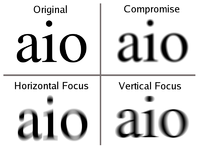
Photo from wikipedia
PURPOSE The application of myopia definition varies considerably within the literature. The purpose of this study was to examine the relationship between different myopia and high myopia definitions and resultant… Click to show full abstract
PURPOSE The application of myopia definition varies considerably within the literature. The purpose of this study was to examine the relationship between different myopia and high myopia definitions and resultant prevalence estimates. METHODS A population-based cross-sectional study of 1,588,508 Israeli adolescents assessed for medical fitness before mandatory military service at the age of 17 years between 1993 through 2015. Participants underwent non-cycloplegic autorefraction. Nine definitions of myopia and seven definitions of high myopia were examined. Prevalence estimates for each definition were calculated and compared with the reference definition (right eye spherical equivalent (SE)≤-0.50D and ≤-6.00D for myopia and high myopia, respectively), to yield a rate ratio (RR) across definitions. RESULTS Applying the right eye SE≤-0.50D reference definition yielded 31.0% myopia prevalence. While some definitions resulted in similar prevalence estimates, using the right eye SE of ≤-0.75D; ≤-1.00D or least minus meridian of ≤-0.75D definitions yielded 28.8%, 26.3%, and 26.9% myopia prevalence, respectively, which corresponded to a 7.1%, 15.1% and 13.4% reduction in myopia RR, respectively. The prevalence of high myopia demonstrated considerable alternations, with a 1.7-fold increase in prevalence for the narrower threshold of SE≤-5.00D compared with SE≤-6.00D reference definition (4.2% and 2.4%, respectively). CONCLUSIONS The prevalence of myopia and especially high myopia varies between frequently applied definitions, considering diverse thresholds, eye lateralization, and spherical vs. astigmatic refractive components. This variability highlights the pressing need for standardization of myopia definition in ophthalmic research. The results of this study provide crude estimates of a "conversion rate" across data, allowing comparisons between studies that utilize different myopia definitions.
Journal Title: Ophthalmic epidemiology
Year Published: 2023
Link to full text (if available)
Share on Social Media: Sign Up to like & get
recommendations!